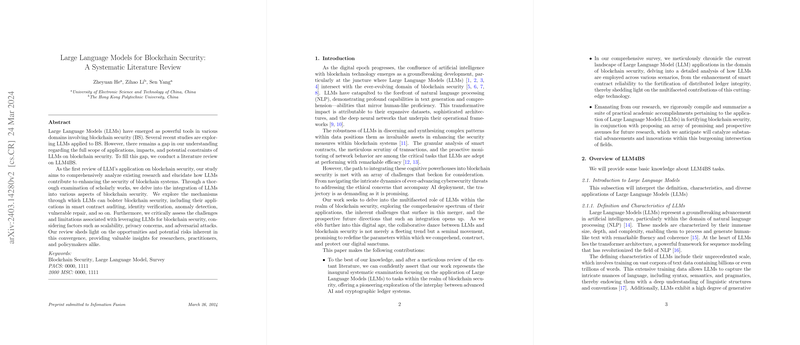LLMs for Enhancing Blockchain Security: A Comprehensive Survey
Introduction
The confluence of artificial intelligence, specifically LLMs, with blockchain technology has unveiled a new frontier in enhancing blockchain security. The systematic literature review conducted in this domain marks a significant stride in understanding the current state of research and the implications of deploying LLMs to fortify blockchain systems against an array of cyber threats. This post explores the salient points of the survey, explores the applications of LLMs in blockchain security, discusses inherent challenges and limitations, and speculates on future research directions.
Overview of LLMs in Blockchain Security (LLM4BS)
Applications of LLMs in Blockchain Security
The implementation of LLMs in blockchain security spans several critical areas, including but not limited to:
- Smart Contract Auditing: LLMs aid in identifying vulnerabilities within smart contracts by understanding code context and logic beyond conventional pattern recognition, offering a nuanced security analysis that traditional tools may overlook.
- Anomaly Detection in Transactions: Through real-time monitoring and the analysis of transaction data, LLMs provide dynamic capabilities to identify and flag suspicious activities, adapting to new patterns of fraudulent transactions.
- Fuzzing for Smart Contract Vulnerabilities: Leveraging LLMs to guide fuzzing processes enables a more focused and efficient search for vulnerabilities within smart contracts, significantly enhancing the depth and accuracy of security audits.
These applications demonstrate LLMs' capacity to process complex data sets and understand intricate patterns, making them invaluable tools in addressing the multifaceted aspects of blockchain security.
Addressing Common Blockchain Security Threats
Key components of blockchain security, such as cryptography and consensus algorithms, along with decentralization principles, are strengthened by integrating LLMs. This integration aids in:
- Mitigating Consensus-Based Attacks: LLMs can identify and address vulnerabilities in consensus mechanisms, offering solutions to prevent 51% attacks and other consensus disruptions.
- Preventing Smart Contract Exploits: By analyzing smart contract code in depth, LLMs play a critical role in detecting and mitigating nuanced vulnerabilities, thus safeguarding against potential exploits.
Taxonomy of LLM4BS Tasks
The survey categorizes LLM applications into distinct tasks, including code auditing for smart contracts, analyzing abnormal transactions, and assisting in the smart contract development lifecycle. This taxonomy facilitates a structured approach to understanding how LLMs contribute to various facets of blockchain security.
Case Studies
Highlighted case studies such as LLM4Fuzz, SMARTINV, and BLOCKGPT offer insights into practical implementations of LLMs in enhancing blockchain security. These examples underscore the advanced capabilities of LLMs in detecting vulnerabilities, guiding security audits, and ensuring the integrity of blockchain transactions.
Future Directions and Challenges
Future research in LLM4BS is poised to tackle several critical areas, including:
- Interdisciplinary Research: Encouraging collaboration across the fields of AI, cybersecurity, and blockchain technology to develop comprehensive security solutions.
- Regulatory Compliance: Navigating the evolving landscape of regulatory requirements and ensuring LLM applications adhere to legal and ethical standards.
- Adapting to Dynamic Security Threats: Enhancing the adaptability of LLMs to counteract novel and sophisticated cyber threats effectively.
- Energy and Sustainability: Addressing the environmental impact of deploying energy-intensive LLMs in blockchain security operations.
The roadmap for LLM4BS emphasizes the importance of addressing these challenges to leverage the full potential of LLMs in securing blockchain systems.
Conclusion
The integration of LLMs into blockchain security represents a pivotal advancement in protecting digital infrastructures. While promising, this integration necessitates ongoing research, ethical considerations, and a commitment to innovation and collaboration. By navigating the outlined challenges and harnessing the power of LLMs, the future of blockchain security appears robust, adaptive, and capable of withstanding the complexities of modern cyber threats. The journey of exploring LLM4BS is just beginning, with much ground to cover in understanding, refining, and implementing these models to create secure, efficient, and trustworthy blockchain systems.
